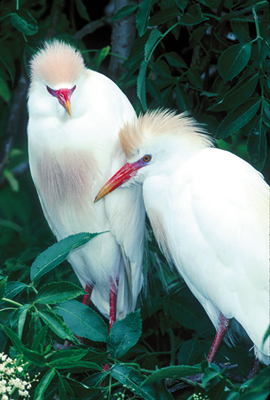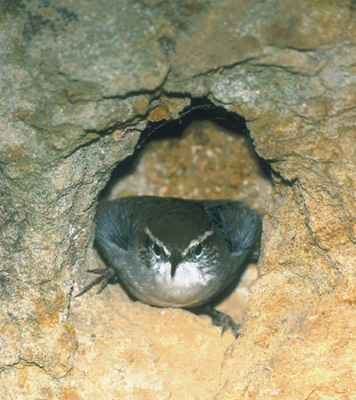Arthur Morris / Birds as Art
Bulletins and Notes Archive
Click any image to enlarge it
|
Bulletins and Notes Archive
|
BIRDS AS ART ON-LINE Bulletin 60 October 21, 2001
Flash Information Update
More on Air Travel with One Carry-On
More on Shipping Big Lenses
Hand On Hand-Checking Film
Flash Information Update
For quite some time, I have been canceling automatic flash
reduction (by setting Custom Function 14-1 on my EOS 3 and EOS
1v camera bodies). I now believe that it is best to leave the
default setting for Automatic Flash Reduction, i.e., Custom
Function 14-0. This allows the camera to reduce the flash
output by an unknown factor, even when working in M
--manual--mode! Both Greg Downing and I have experimented
using both approaches (CF 14-0 and CF 14-1) for some time now
and agree that results are far more consistent when using CF
14-0. (Note: though I do not know the details, Nikon users
and others have similar options when working with their
manufacturer's high-end camera bodies.) For reasons unknown,
Canon's automatic flash reduction program prevents
(occasional) severe over-flashing, i.e.., overexposure caused
by the flash.
As for fill levels, I use -1 1/3 for white and extremely
light-toned subjects, -2/3 or -1 for middle-tones, and 1/3 or
-2/3 for dark-toned subjects. When using flash as main light
(where I opt to work in M (manual) mode, I generally set the
flash at 0 or -1/3 white or light-toned subjects, 0 for middle
toned subjects, and +1/3 for dark or black subjects. If you
are not rock-solid in your understanding of the terms "flash
as fill" and "flash as main light," you are invited to refer
to pages 74-77 in "The Art of Bird Photography." (You can
order a signed copy of the book off of the web site.)

Cattle Egret pair, St.
Augustine Alligator Farm. Canon 600mm f/4 L IS lens, EOS 1v
camera body, Better Beamer, Fuji Velvia pushed one stop.
Ambient: Evaluative Metering +2/3 stop. Fill flash at -1.
(CF-14-0)

Bewick's Wren, LaJolla,
California. Photographed at 9:30 pm in night-time roost
hole.
Canon 600mm f/4 L IS
lens, EOS 1v body, 1.4 X II teleconverter, and 37 mm of
extension, Better Beamer. Flash as main light at +1/3
stop to bring up detail in the bird's dark chocolate cap.
More on Air Travel with One Carry-On
Many folks have written asking which brand of
rolling (flight attendant-type) bag I use.
Presently, it is an American Tourister. The basic
models of the standard name brands are all pretty
similar--the zippers usually break after a year or
two of hard service... The rolling bag that I use
has no padding at all. This is fine with me as
the bag is in my control at all times;
ample padding just adds weight, and the more
padding that there is, the less stuff you can
place in the bag. (The maximum size of the
rolling bag is--of course--pre-determined.) When
I arrive at my location, I simply place the bag in
the trunk and unzip it. It serves as my "camera
bag" until I am ready to head home.
As described in "The Art of Bird Photography," my
smaller lenses (including intermediate telephotos)
and camera bodies are always placed in heavy wool
watch caps. These protect the equipment from both
bump, jarring, and moisture, and makes packing a
snap.
I am not at all familiar with any of
the large-wheeled, padded models...
More on Shipping Big Lenses
Bulletin subscriber
Jeff Page e-mailed the following excellent suggestion:
Depending on how much
bumping around your parcel gets, it is possible for your
big lens or other fragile equipment to sink amid the
little foam balls and be too close to the bottom (where
it might be damaged). I have heard direct reports of
baggage handlers chucking stuff from the plane from 20
feet up to the ground because they were too impatient to
wait for the truck to arrive. Consider
putting the balls themselves in a plastic bag as well,
so that the lens can't sink through.
Thanks Jeff!
More on
Hand-Checking Film
Some solid info from Bulletin subscribers and IPT
participants Bill and Carolyn Hilton:
You and your readers may be interested in this web page
with the actual FAA rules and regs, which describe your
right to request a hand-check of your film. I've
printed off a copy and now carry it with me so I can
quote scripture and verse in case I encounter an
over-zealous security guard. Though I have flown with
film a couple of times after Sept 11 I have not had
any problems getting my film hand-checked. These
rules are current (last updated Oct 2001, per the web
site).
Here is the relevant section is 108.17.e which reads in
part ...
<quote>
(e) No certificate holder may use an X-ray system to
inspect carry-on or checked articles unless a sign is
posted in a conspicuous place at the screening station
and on the X-ray system which notifies passengers that
such items are being inspected by an X-ray and advises
them to remove all X-ray, scientific, and high-speed
film from carry-on and checked articles before
inspection. This sign shall also advise passengers that
they may request that an inspection be made of their
photographic equipment and film packages without
exposure to an X-ray system. ... If requested by
passengers, their photographic equipment and film
packages shall be inspected without exposure to an
X-ray system.
<end quote>
Section 108.17 "Use of x-ray systems" is on-line at this
URL:
http://www.access.gpo.gov/nara/cfr/cfrhtml_00/Title_14/14cfr108_00.html
The main menu for all
the rules is at
http://www.access.gpo.gov/nara/cfr/cfrhtml_00/Title_14/14tab_00.html
Thank you Bill and
Carolyn!
IMHO, if you are told that you
must pass your film through the security X-ray,
you might consider requesting to speak to a supervisor,
but if push comes to shove, you may be forced (FAA
regulations on your side or not...) to have your film
X-rayed. In any case, all of the 100 and 200 ISO films
that we use regularly can be X-rayed many times by the
machines at the security checkpoints without damage.
|
]
[
About Arthur
|
|
]
[ Photo-Tours
|
Books |
Photo Prints
]
[ Bulletin Archive
| FAQ
]
[
Accessories
|
Links ]
|